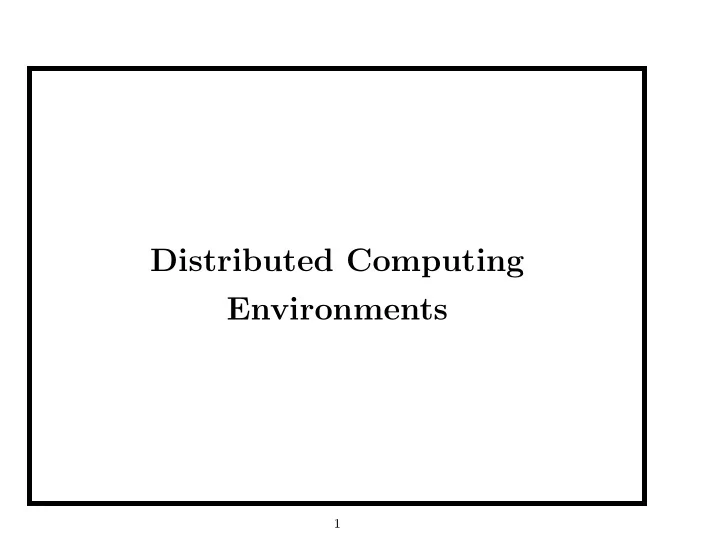

Distributed Computing Environments 1
Distributed computing environment • consists of entities • entities communicate with each other • the goal is to find a solution to a common problem 2
Entities • entity: a computational unit of a distributed computing environment – e.g. a computer, a processor, a process, etc. • operations: – local storage and processing – transmission of messages – (re)setting of the alarm clock – changing the value of the status registers 3
External events • an entity is reactive (i.e. it only responds to external stimuli) • external events: – (1) arrival of a message – (2) ringing of the alarm clock – (3) spontaneous impulse • events (1) and (2) originate within the system • event (3) originates outside the system 4
Actions and behavior • entity reacts to an event by an action • an action is a finite, indivisible (atomic) and terminating sequence of operations • an action is determined by the behavior and the current status • behavior is a complete and unambiguous set of rules • a rule is in the form of status × event → action • current status is determined by the status register 5
Communication • entities communicate by transmitting and receiving messages • a message is a finite sequence of bits • an entity can only communicate with its neighbors – it can send messages to its out-neighbors – it can receive messages from its in-neighbors – the set of in-neighbors is not necessarily equal to the set of out-neighbors 6
Axioms • axiom 1: finite communication delays – in the absence of failures, communications delays are finite • axiom 2: local orientation – an entity can distinguish among its in- and out-neighbors 7
Restrictions • a restriction is an additional property of the system • common restrictions: – message ordering – reciprocal communication – bidirectional links – edge/entity failure detection – guaranteed delivery – partial/total reliability – connectivity – bounded communication delays – synchronized clocks 8
Cost and complexity • measuring efficiency of an algorithm in different systems needs some abstract and general cost measures • amount of communication activities – the number of message transmissions – the number of bits transmitted • time – total execution delay: the delay between start and end of a computation in the system – cannot be accurately measured (without assumptions, delays are unpredictable) 9
Levels of knowledge • local knowledge: p ∈ LK t [ x ] – local information of an entity (contents of its memory) • implicit knowledge: p ∈ IK t [ W ] iff ∃ x ∈ W ( p ∈ LK t [ x ]) – at least one entity x knows p • explicit knowledge: p ∈ EK t [ W ] iff ∀ x ∈ W ( p ∈ LK t [ x ]) – every entity in the group W knows p • common knowledge: p ∈ CK t [ W ] iff ∧ 1 ≤ i ≤∞ P i , where P 1 = [ p ∈ EK t [ W ]] and P i +1 = [ P i ∈ EK t [ W ]] – every entity knows p , and every entity knows that every entity knows p , and every entity knows that every entity knows that every entity knows p , and so on 10
Example of common knowledge There’s a room with k people who have blue eyes. Rest of the people have green eyes. A person doesn’t know the color of his/her eyes. People cannot communicate with each other, nor are there any mirrors in the room. If a person finds out to have blue eyes, he/she must leave the room in the next morning. An outsider visits the room and announces, that there’s at least one blue-eyed people in the room. Can a person find out the color of his/her eyes and is it possible for all blue-eyed people to exit the room together? 11
Summary • the computational unit of a distributed environment is called an entity • entites can do local processing and communicate with other entities • external events: arrival of a message, alarm clock ring and spontaneous impulse • there can be assumptions (restrictions) about the environment • communication activity and execution delay are measures of efficiency of an algorithm • sometimes it is necessary for entities to reach a consensus 12
Thank you! Questions? 13
Recommend
More recommend